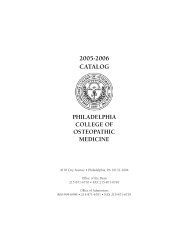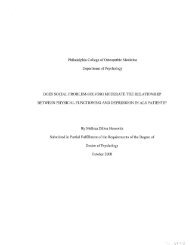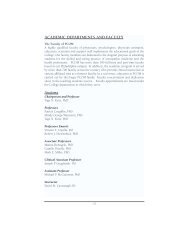0 - Philadelphia College of Osteopathic Medicine
0 - Philadelphia College of Osteopathic Medicine
0 - Philadelphia College of Osteopathic Medicine
Create successful ePaper yourself
Turn your PDF publications into a flip-book with our unique Google optimized e-Paper software.
BiopsychosociaJ Effects Among Coronary Artery Bypass Grafting Patients 20<br />
The health belief model has a vast history because it was developed in the 1950's<br />
by social psychologists who were attempting to understand the zeitgeist <strong>of</strong> wide spread<br />
failure to accept disease preventatives and early screening tests for asymptomatic diseases<br />
(Clark & Becker, 1998). More recently, it was assumed that knowledge guides health<br />
related behavior (Hirani & Nevv111aJ1, 2005). Traditionally in clinical practice, necessary<br />
information is provided to patients regarding their current diagnosis and illness and in<br />
turn it is felt that the patients' knowledge drives adherence. This approach implies a<br />
passive role for patients, resulting in surprise at some patients' health related decisions<br />
and behaviors. Physicians deemed these choices as counterproductive for their health,<br />
contrary to medical advice or sometimes idiosyncratic. However, it has become apparent<br />
that the behaviors <strong>of</strong> individuals are affected by the attitudes and beliefs they hold (Kelly,<br />
2005).<br />
Ifindividuals think something's are appropriate for them, they may do them; if<br />
not, they do not. With regards to health or ill health, beliefs and attitudes may be related<br />
to undergoing treatments, current medications, or performing health maintenaJ1ce<br />
behaviors (Hirani, & Ne\\






